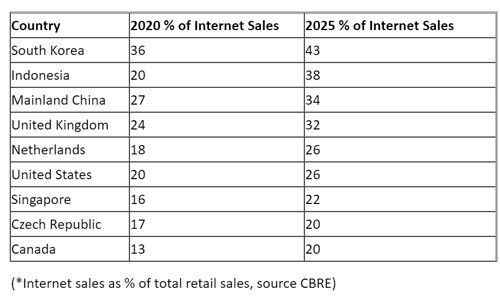Commercial Real Estate News

Global E-commerce Growth Needs 1.5 Billion Square Feet of New Distribution Space
Commercial News » Seoul Edition | By Michael Gerrity | August 19, 2021 8:53 AM ET
U.S. alone needs 330 million sq. ft. of new warehouse space by 2025
According to international property consultant CBRE, e-commerce penetration is expected to grow to 26 percent of all retail sales by 2025, the U.S. will need an additional 330 million sq. ft. of distribution space just to handle the increase in online ordering in that timeframe.
That anticipated, e-commerce-generated demand for another 330 million sq. ft. of distribution space represents 27 percent of the projected overall demand for industrial real estate in the U.S. through 2025, according to CBRE Econometric Advisors. The broader category of industrial real estate includes warehouses for traditional retail distribution, manufacturing, R&D space and data centers.
CBRE forecasted the incremental demand based on its estimate that every additional $1 billion of e-commerce sales requires 1 million sq. ft. of new distribution space. According to CBRE's forecast, which is based on Euromonitor data for 2020, U.S. e-commerce sales are expected to increase $330B from 2020 to 2025. Globally, e-commerce sales are forecast to rise by $1.5 trillion in this same time period, requiring an additional 1.5 billion sq. ft. of warehouse/distribution space to accommodate this growth. The U.S. and Mainland China are the biggest e-commerce markets in the world, accounting for 57 percent of global Internet sales.
"E-commerce has grown steadily over the years, and it will continue at a strong pace for the foreseeable future," said John Morris, Executive Managing Director and Leader of CBRE's Americas Industrial & Logistics and Retail businesses. "As a result, distribution and supply chain networks will continue to be under pressure to meet demand at a time when industrial vacancy is at record low levels. A significant amount of new construction will be needed in the next few years just to keep pace with robust demand."
According to the CBRE report, South Korea is forecast to have the world's highest e-commerce penetration in 2025 at 43 percent. The U.S. will be one of the top 10 markets globally for e-commerce penetration in 2025. To forecast growth, CBRE looked at such drivers as each country's percentage of urban population, debit and credit card use, the population's digital skills and digital technology infrastructure.
"While there is a sizable construction pipeline in the U.S., much of that new space already is leased to meet the demand of the past few years," said James Breeze, Senior Director and Global Head of Industrial & Logistics Research for CBRE. "Moving forward, the challenge in many U.S. and global markets will be to produce enough new facilities to meet this rapidly expanding market. It's important to bear in mind that e-commerce is only a portion of the overall demand for distribution facilities. Traditional retailers, third party logistics companies and others will also be demand catalysts. If developers can't build facilities fast enough, we could see rental rates push well beyond their current record highs."

Sign Up Free | The WPJ Weekly Newsletter
Relevant real estate news.
Actionable market intelligence.
Right to your inbox every week.
Real Estate Listings Showcase












Related News Stories
Commercial Real Estate Headlines
- 2025 Prediction: U.S. Commercial Investment Recovery Expected to Gain Traction
- Holiday Retail Sales for 2024 to Hit Record $1 Trillion
- Tech, AI Industries Drive Largest Share of Office Leasing Activity in U.S.
- Commercial Real Estate Lending in U.S. Enjoys Strong Growth in Q3
- U.S. Multifamily Market Begins Recovery in Q3
- Commercial Investment in Japan Spikes 24 Percent Annually in Q3
- Despite Return-to-Office Mandates, U.S. Office Vacancies Continue to Rise
- PROPSIG Tech Startup Acquired by World Property Data
- U.S. Commercial Mortgage Debt Hits $4.7 Trillion in Q2 as Delinquencies Increase
- Hong Kong Class A Office Rents Continue to Downtick in Mid-Summer
- U.S. Office Landlords Tenant Concessions Decline for First Time in 4 Years
- U.S. Commercial Mortgage Originations Spike 27 Percent in Q2 Over Q1
- Phnom Penh's Commercial Office, Retail Markets Face Slowdowns in 2024
- Global Edge Data Center Market to Hit $300 Billion by 2026
- Commercial Property Transactions in Japan Dive 25 Percent Annually in Q2
- Delinquency Rates for U.S. Commercial Property Loans Downticks in Q2
- Megawarehouse Lease Deals in U.S. Increase in 2024
- Office Tenants' Flight to Quality Buildings Increases in 2024
- Commercial Lending in Japan Upticks 6 Percent Annually in Q1
- AI Driving Significant Global Data Center Growth in 2024
- Total U.S. Commercial Mortgage Debt Rises to $4.7 Trillion in Q1
- U.S. Commercial Mortgage Delinquencies Rise in Early 2024
- Asia Pacific Office Sector to Further Reprice Throughout 2024
- U.S. Retail Foot Traffic to Surpass Pre-Pandemic Levels by 2025
- Commercial Real Estate Lending in U.S. Slowed in First Quarter
- Japan Commercial Property Investment Volume Jumps 7 Percent in Q1
- Asia Pacific Commercial Property Investment Leads the World, Spikes 13 Percent
- Driven by High Rates, U.S. Commercial Lending Imploded 47 Percent in 2023
- After Two Year Slump, Prime Multifamily Metrics Uptick in U.S.
- Commercial Co-Broker Commissions Not Affected by NAR-DOJ Settlement, Yet
- U.S. Office Buildings with Upscale Tenant Amenities Still Enjoy Premium Rents in 2024
- U.S. Commercial, Multifamily Mortgage Delinquency Rates Uptick in Q4
- U.S. Commercial Mortgage Debt Continued to Rise in 2023, Hits $4.7 Trillion
- Nonresidential Construction Spending in the U.S. Falls Sharply in January
- U.S. Multifamily Construction Starts to Decline in 2024
- Commercial Mortgage Lending in U.S. Shows Signs of Stabilization in Late 2023
- Architecture Billings Decline in December as Soft Business Conditions Persist
- Government Sector Claimed Largest Portion of 100 Biggest U.S. Office Leases Signed in 2023
- U.S. Commercial, Multifamily Borrowing Dives 25 Percent Annually in Late 2023
- Record High Multifamily Construction Deliveries Drive Vacancy Rates Higher
Reader Poll
In 2025, which region of the world are you most likely to buy or invest in real estate?





